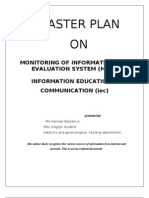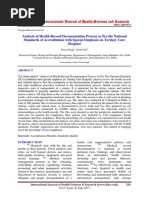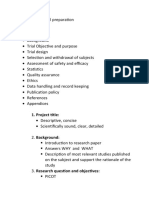Chandrakant Development Friendly Wel Baby Clinic
Chandrakant Development Friendly Wel Baby Clinic
Uploaded by
api-228136529Copyright:
Available Formats
Chandrakant Development Friendly Wel Baby Clinic
Chandrakant Development Friendly Wel Baby Clinic
Uploaded by
api-228136529Original Title
Copyright
Available Formats
Share this document
Did you find this document useful?
Is this content inappropriate?
Copyright:
Available Formats
Chandrakant Development Friendly Wel Baby Clinic
Chandrakant Development Friendly Wel Baby Clinic
Uploaded by
api-228136529Copyright:
Available Formats
Development Friendly Well Baby Clinic
Background:
Increasing incidence of miraculous salvaging of very low birth weight babies has increased
the incidence of developmental delay and deviances. About 10% of the world’s population
has some form of disability(WHO). In India, 3.8% of the population has some form of
disability and the same was found to be more common among children of the lowest
socioeconomic class families when compared with the next-to-lowest class families. The
prevalence of developmental delay, deviation, deformity or disability among the under-five
children .
Early Child Care and Development (ECCD) is a comprehensive approach specially aimed at
providing opportunities for the development of children at the age group of 0-8 years.
Varied strategies have been used, singly or in combination for the betterment of the
children’s health, nutritional status, psychological development, early childhood education
or child education. ECCD programs, whether parent focused or child centred, help
disadvantaged children directly or indirectly, to combat to a certain extent, the detrimental
effects of poverty on child development especially during the crucial first six years of life.
ECCD programs in most of the developing countries are not always planned and
implemented with a clear understanding of the issues specific to the urban poor living in
slums and peri-urban settlements; with the result that a greater percentage of under fives in
the poor urban areas still remain un-reached by any early child development programs.
Developmental status - an early child development indicator (WHO):
A country’s future human resource development is determined on the basis of the
developmental indices like infant mortality, morbidity, prevalence of disability, living
conditions and education of children, especially the under fives. As early child development
is objectively reflected in the developmental status of children, any delay, dissociation or
deviation in the development of children and its causes/contributory factors may be
indicative of the need for strengthening the existing programs or the need for exploring and
initiating newer possibilities.
Rrisk factors for development delay:
A. Biological risk factors
Low birth weight is the single most important biological risk factor for developmental
delay.Health care practices like incomplete immunization, insufficient check up during
pregnancy, unsafe deliveries at home and improper post-natal care of mothers and
newborn increase the risk factors for developmental delay. Infection with rubella in the
first trimester of pregnancy, intrauterine infections, premature delivery, perinatal
problems like birth asphyxia, hypothermia, and hypoglycaemia, post asphyxial
encephalopathy is the best clinical marker for outcome.
B. Environmental risk factors
The primary environment of any individual especially during infancy, is the family and more
so, the mother.Hence a child with environmental risk of living in deprived settlements may
sometimes present with developmental delay. As child development is said to be the
interplay between genetic and environmental factors, a child living in deprived
environmental settlements(Poverty, substandard housing, overcrowding, inadequate water,
sanitation and sewage disposal facilities) may present with developmental delay.
Early Child Development Programs and Their problems:
1) Integrated Child Development Services (ICDS) ; The largest and most important
network of services for rural poor but limited for urba
2) Urban Basic Services (UBS)
3) Anganwadis
4) Mobile crèches( which aim to relieve the older child from the burden of rearing the
younger ones by providing services like creche, preschool education and primary
schools)
5) The Balwadi program functioning in the urban areas on a moderate scale under the
Central Social Welfare Board and Indian Council for Child Welfare focuses on natal
and postnatal services, arts and crafts training, elementary medical services and
preschool program for children between two and a half to five years.
The problems faced by the ECCD programs of urban settlements are; inadequate
infrastructure due to minimal funds, poor honorarium of workers, unqualified and poorly
skilled staff, lack of services for the under three, over importance to one or more
components thereby neglecting other vital components of early child development,
worker’s lack of knowledge and skill in infant stimulation, early identification of
developmental delay in children, lack of community participation and ownership of the
program and absence of outreach programs. In India, a feasible and sustainable model for
early developmental intervention would be through community owned early child care and
development facilities, preferably within the ambit of current national programs viz., NRHM,
ICDS and the Sarva Shiksha Abhiyan.
Following are the Replicable working models/services to strengthen early child
development:i )Infant stimulation ii) A community based model of early identification and
intervention of developmental delay iii) Community Extension Services iv) Child development
referral units (CDRU) v) Development friendly well baby clinic vi) Developmental screening for
toddlers vii) Community owned ECD centres viii) Skill assessment of preschool children ix) School
readiness program x) Child to child approach xi) Primary education enhancement program
xii)Identification of mental sub-normality in primary school children.
Development Friendly Well Baby Clinic:
It is now well appreciated that there are great many children presenting with developmental
delay and spasticity, who do not have identifiable risk factors. Hence, ideally all babies should be
assessed at least once during infancy. Well Baby Clinics, now functioning for a number of years as a
facility meant for comprehensive preventive health care for infants and children have over the years
been reduced to only an immunization clinic. The well baby clinics functioning in connection with
urban health centres may be an ideal place to offer developmental assessment using tools like. An
ideal Child Development Centre(CDC) has the following components:(i) Monitoring (ii)
Assessment (iii) Early intervention(iv) Therapy (v) Integration (vi) Research, and (vii)
Community/social application. Comprehensive and Integrated management are the keystones of a
successful CDC.
Guidelines:
1) Screening and assessment should be viewed as services- as part of the intervention
process and not only as a means of identification and measurement.
6) Process, procedures, and instruments intended for screening and assessment should
only be used for their specified purposes.
7) Multiple sources of information should be included in screening and assessment
processes.
8) Developmental screening should take place on a recurrent or periodic basis. It is
inappropriate to screen young children only once during their early years. Similarly,
provisions should be made for re-evaluation or reassessment after the need for
services has been initiated.
9) Developmental screening should be viewed as only one path to insure in depth
assessment. Failure to qualify for services based on a single source of screening
information should not become a barrier to further evaluation for intervention
services if other risk factors (e.g. environmental, medical, familial) are present.
10) Screening and assessment procedures should be reliable and valid.
11) Family members should be an integral part of the screening and assessment process.
Information provided by family members is critically important for determining
whether or not to initiate more in depth assessment and for designing appropriate
intervention strategies. Parents should be accorded complete informed consent at
all stages of the screening and assessment process.
12) During screening and assessment of developmental strength and problems, the
more relevant and familiar the tasks and setting are to the child and the child’s
family, the more likely it is that the results will be valid
13) All tests, procedures and processes intended for screening or assessment must be
culturally sensitive.
14) Those who screen and assess very young children need extensive and
comprehensive training.
Periodicity:
The frequency and content foe well child care activities are derived from evidence based
practice and research. It is guide to paediatric health providers to perform certain services
and make observations at age specific visits and it designates the standard for preventive
services for children and youth.
Tasks:
The well child visit encounter to promote the physical and emotional wellbeing of children
and youth. Child health professional should take advantage of the opportunity well child
visits provide to elicit parental questions and concerns, gather relevant family & individual
health information perform physical examination and initiate screening tests.
Tasks of well baby care visits include – Disease detection, Disease Prevention, Health
Promotion and Anticipatory Guidance. To achieve these outcomes, following strategy
should be followed.
Developmental Surveillance: This is the ongoing process of monitoring individual children’s
developmental status and should be incorporated at each maintence visit. Involves eliciting
and attending to parental concerns about their children’s development e.g. age specific
queries like child is walking, talking, pointing. It is a kind of a developmental growth chart.
Recognition of children who are at risk of developmental delay is the goal of developmental
surveillance.
Developmental screening: is the administration of a brief standardized tool to identify
children at risk of a developmental disorder. It should be performed when developmental
surveillance elicits a risk factor for developmental delay. AAP (American academy of
Paediatrics ); in spite of parental concern or in the absence of established risk factors,
recommends application of tools at the 9,18 and 30 months health visit. In addition to
general screening tools, autism specific screening tool should also be administered at the
age of 18 months. Screening instruments should have a broad developmental focus and
should be brief, inexpensive, valid and reliable.
Commonly used developmental tools include – DDST II (Denver developmental screening
test II), DOC (developmental observation card),TDSC(Trivandrum developmental screening
chart),DASSI(Developmental assessment scale for Indian infants), neurodevelopmental
evaluation – Amiel Tison method, STYCAR vision tests, identification of retinopathy of
prematurity.
Developmental Evaluation (Assessment): is performed when surveillance and screening
identifies a child as being at risk of a developmental disorder. The main aim is to identify the
specific developmental disorder or disorders affecting the child. It is performed by trained
persons.
Developmental Therapy: Therapist should give therapy to minimize the disability or to
prevent further delay. Therapy includes speech therapy, physiotherapy, occupational
therapy, neuro developmental therapy and prevention of retinopathy of prematurity.
The Benefits of Well-Child Visits:
Prevention: Your child gets scheduled immunizations to prevent illness. You also can
ask your paediatrician about nutrition and safety in the home and at school.
Tracking growth and development: See how much your child has grown in the time
since your last visit, and talk with your doctor about your child's development. You
can discuss your child's milestones, social behaviours and learning.
Raising concerns: Make a list of topics you want to talk about with your child's
paediatrician such as development, behaviour, sleep, eating or getting along with
other family members. Bring your top three to five questions or concerns with you to
talk with your paediatrician at the start of the visit.
Team approach: Regular visits create strong, trustworthy relationships among
paediatrician, parent and child. The AAP recommends well-child visits as a way for
paediatricians and parents to serve the needs of children. This team approach helps
develop optimal physical, mental and social health of a child.
You might also like
- Hypertrophy Cluster Training HCT-12Document23 pagesHypertrophy Cluster Training HCT-12Luis Montilla100% (6)
- PPTCT Policy Guideline PDFDocument31 pagesPPTCT Policy Guideline PDFPabhat KumarNo ratings yet
- Hospitalist Program Toolkit: A Comprehensive Guide to Implementation of Successful Hospitalist ProgramsFrom EverandHospitalist Program Toolkit: A Comprehensive Guide to Implementation of Successful Hospitalist ProgramsNo ratings yet
- Quality Assurance of Nursing Performance in Surgical WardsDocument19 pagesQuality Assurance of Nursing Performance in Surgical WardsGelo CayetanoNo ratings yet
- Nursing AuditDocument5 pagesNursing AuditGAGANJOT850% (1)
- Small Family NormDocument21 pagesSmall Family NormKailash NagarNo ratings yet
- School AssessmentDocument7 pagesSchool Assessmentapi-283715868No ratings yet
- Institutional HealthDocument2 pagesInstitutional HealthKakembo NoreenNo ratings yet
- Patient SystemDocument4 pagesPatient SystemPraveen ThulasiNo ratings yet
- And Utilization of Nursing ResourcesDocument10 pagesAnd Utilization of Nursing ResourcesSimran Chauhan100% (1)
- M.SC Nursing - 2019 - 2 - Clinical Speciality II - Paediatric (Child Health) Nursing PDFDocument1 pageM.SC Nursing - 2019 - 2 - Clinical Speciality II - Paediatric (Child Health) Nursing PDFPriyanjali SainiNo ratings yet
- Nursing AuditDocument7 pagesNursing AuditSam ParkNo ratings yet
- Patient Grievance ProcedureDocument8 pagesPatient Grievance ProcedureLino Marcus ViolaNo ratings yet
- Rastriya Bal Swasthya KaryakaramDocument3 pagesRastriya Bal Swasthya KaryakaramSachin ParmarNo ratings yet
- Submitted by Balkeej Kaur MSC 1 Year Acon, Sri Muktsar SahibDocument41 pagesSubmitted by Balkeej Kaur MSC 1 Year Acon, Sri Muktsar SahibmalathiNo ratings yet
- IPHS Fo SC PHC CHCDocument18 pagesIPHS Fo SC PHC CHCDrArun SinghNo ratings yet
- Nursing AuditDocument21 pagesNursing AuditSam Tully0% (1)
- National Aids Control Programme Phase-Iv Current Status and Critical AppraisalDocument71 pagesNational Aids Control Programme Phase-Iv Current Status and Critical AppraisalNeethu Vincent100% (1)
- Health Care Deliver System AjayDocument41 pagesHealth Care Deliver System AjayAjay DNo ratings yet
- PDFDocument5 pagesPDFKinjal VasavaNo ratings yet
- Under Five Clinic Visit NEW ONEDocument14 pagesUnder Five Clinic Visit NEW ONESusmita SenNo ratings yet
- School Health ReportDocument5 pagesSchool Health Reportzinto vilaneNo ratings yet
- Cumulative Record ReportDocument6 pagesCumulative Record ReportMahek BurondkarNo ratings yet
- Nursing Care Plan and Nightingale's Environmental TheoryDocument4 pagesNursing Care Plan and Nightingale's Environmental TheoryBALDOZA LEO FRANCO B.No ratings yet
- MPHW M 2010 GuidelineDocument29 pagesMPHW M 2010 GuidelineTesfaye Teferi ShoneNo ratings yet
- Commercial Sex WorkersDocument13 pagesCommercial Sex WorkersDONA BIBINNo ratings yet
- FWPDocument37 pagesFWPhemaanandhyNo ratings yet
- Ayushman Bharat:: Comprehensive Primary Health Care Through Health and Wellness CentersDocument96 pagesAyushman Bharat:: Comprehensive Primary Health Care Through Health and Wellness CentersSiva SaranNo ratings yet
- Updated Operational Guidelines For Mission IndradhanushDocument76 pagesUpdated Operational Guidelines For Mission IndradhanushZLOOffice BankuraNo ratings yet
- School Health ProgrammeDocument40 pagesSchool Health ProgrammezulfitrieeeNo ratings yet
- Materials Management in Primary Health Centre: A Process MappingDocument17 pagesMaterials Management in Primary Health Centre: A Process MappingAkansha JohnNo ratings yet
- Seminar MiesDocument16 pagesSeminar Mieshannahashok0% (1)
- A Study To Assess The Knowledge, Attitude and Practice Among TB Patients Under Going Dots Treatment in A Tertiary Care Government HospitalDocument60 pagesA Study To Assess The Knowledge, Attitude and Practice Among TB Patients Under Going Dots Treatment in A Tertiary Care Government HospitalNirmal Joseph EmmanuelNo ratings yet
- Antenatal & Postnatal Care: 1. General InformationDocument7 pagesAntenatal & Postnatal Care: 1. General InformationanishnithaNo ratings yet
- Little Schmidy Falls Risk AssessmentDocument1 pageLittle Schmidy Falls Risk AssessmentrenystrawberryNo ratings yet
- Nosocomial Infections in NewbornsDocument10 pagesNosocomial Infections in NewbornsAntony Rose AbyNo ratings yet
- Antenantal CareDocument35 pagesAntenantal Carejohn mwambuNo ratings yet
- Participate IN Various Programmes VasectomyDocument6 pagesParticipate IN Various Programmes Vasectomyvenkat krishnanNo ratings yet
- A Study To Assess The Effectiveness of VAT On Knowledge Regarding Janani Suraksha Yojana Among Mothers of Selected Rural Area at Bangalore, Karnataka, IndiaDocument3 pagesA Study To Assess The Effectiveness of VAT On Knowledge Regarding Janani Suraksha Yojana Among Mothers of Selected Rural Area at Bangalore, Karnataka, IndiaAnonymous izrFWiQNo ratings yet
- Health Insurance: Pramod KumarDocument21 pagesHealth Insurance: Pramod KumarSuneel Kumar PrajapatiNo ratings yet
- Nabh Tertiary CareDocument7 pagesNabh Tertiary CareGold PANDINo ratings yet
- A Study To Assess The Effectiveness of Planned Teaching Programme On Febrile Convulsions Among The Parents of Under 5 Children in BD Bhajoriya Rajkiya Hospital SaharanpurDocument4 pagesA Study To Assess The Effectiveness of Planned Teaching Programme On Febrile Convulsions Among The Parents of Under 5 Children in BD Bhajoriya Rajkiya Hospital SaharanpurEditor IJTSRDNo ratings yet
- Cancer QuizDocument3 pagesCancer QuizOsama AtifNo ratings yet
- Prevalence of Anemia Among Adolescent GirlsDocument6 pagesPrevalence of Anemia Among Adolescent GirlsYolanda SimamoraNo ratings yet
- Mid Day Meal ProgrammeDocument13 pagesMid Day Meal Programmeyash myatraNo ratings yet
- Documentation, Nursing Rounds, Manual & ProtocolDocument22 pagesDocumentation, Nursing Rounds, Manual & ProtocolSUNNY__SIJINo ratings yet
- FICCI Heal Report Final 27-08-2016Document56 pagesFICCI Heal Report Final 27-08-2016deepikaNo ratings yet
- Back CareDocument20 pagesBack Caresafina khstoonNo ratings yet
- Communicable DiseasesDocument56 pagesCommunicable DiseasesLili Nini100% (1)
- Nursing InformaticsDocument5 pagesNursing InformaticsQuaynie SulongNo ratings yet
- Health Care Delivery Concerns, National Health andDocument26 pagesHealth Care Delivery Concerns, National Health and421Karanbir Kaur100% (1)
- National Urban Health Mission (NUHM) : Orientation Workshop For ACS/PS/Sec (Health) & MD (NHM)Document18 pagesNational Urban Health Mission (NUHM) : Orientation Workshop For ACS/PS/Sec (Health) & MD (NHM)leoNo ratings yet
- Effectiveness of Planned Teaching Programme On Knowledge Regarding Identification of Danger Signs in Neonates Among Post-Natal MothersDocument4 pagesEffectiveness of Planned Teaching Programme On Knowledge Regarding Identification of Danger Signs in Neonates Among Post-Natal MothersInternational Journal of Innovative Science and Research TechnologyNo ratings yet
- Importance and Purposes of ResearchDocument3 pagesImportance and Purposes of ResearchKarl Kiw-isNo ratings yet
- Concept of Preventive PaediatricDocument5 pagesConcept of Preventive PaediatricJenish Panchal0% (1)
- Optimizing Breastfeeding For Better Health Outcomes The Way ForwardDocument4 pagesOptimizing Breastfeeding For Better Health Outcomes The Way ForwardEditor IJTSRDNo ratings yet
- National Health and FamilyDocument16 pagesNational Health and FamilyshivaniNo ratings yet
- By:-Firoz Qureshi Dept. Psychiatric NursingDocument46 pagesBy:-Firoz Qureshi Dept. Psychiatric NursingrajeshwariNo ratings yet
- Preparation OF Group Work: Netaji Subhash College of NursingDocument7 pagesPreparation OF Group Work: Netaji Subhash College of NursingDimpal ChoudharyNo ratings yet
- SEMINAR ON ImnciDocument8 pagesSEMINAR ON Imncivineeta.ashoknagar100% (1)
- Learning and Memory - Physiological Psychology - DRDocument16 pagesLearning and Memory - Physiological Psychology - DRapi-228136529No ratings yet
- Talk 1 Symptomatogenesis Autism and Therapeutic ImplicationsDocument75 pagesTalk 1 Symptomatogenesis Autism and Therapeutic Implicationsapi-228136529No ratings yet
- Talk 2 Abcdef of Autism1Document23 pagesTalk 2 Abcdef of Autism1api-228136529No ratings yet
- Weekly Objective Autism Symptom Monitoring ChartDocument3 pagesWeekly Objective Autism Symptom Monitoring Chartapi-228136529No ratings yet
- Talk 3 Autism ChangeDocument32 pagesTalk 3 Autism Changeapi-228136529No ratings yet
- FinalautismbookletDocument10 pagesFinalautismbookletapi-228136529No ratings yet
- Case Control StudyDocument5 pagesCase Control Studyapi-228136529No ratings yet
- Piaget FinalDocument9 pagesPiaget Finalapi-228136529No ratings yet
- Research ProtocolDocument4 pagesResearch Protocolapi-228136529No ratings yet
- Asd FinalDocument9 pagesAsd Finalapi-228136529No ratings yet
- NDT FinalDocument8 pagesNDT Finalapi-228136529No ratings yet
- Adhd Newer DevDocument11 pagesAdhd Newer Devapi-228136529No ratings yet
- Learning Disability FinalDocument9 pagesLearning Disability Finalapi-228136529No ratings yet
- Pisharody Genetic CounselingDocument15 pagesPisharody Genetic Counselingapi-228136529No ratings yet
- Speech CommunicationDocument2 pagesSpeech Communicationapi-228136529No ratings yet
- Shyamal Neuronal Migration DisorderDocument3 pagesShyamal Neuronal Migration Disorderapi-228136529No ratings yet
- Disruptive Behavioral DisorderDocument5 pagesDisruptive Behavioral Disorderapi-228136529100% (1)
- Barkha Binet 2Document2 pagesBarkha Binet 2api-228136529No ratings yet
- Barkha Misic 1Document4 pagesBarkha Misic 1api-2281365290% (1)
- Shyamal Complementary Health ApproachesDocument4 pagesShyamal Complementary Health Approachesapi-228136529No ratings yet
- Manohar Scholastic BackwardnessDocument5 pagesManohar Scholastic Backwardnessapi-228136529No ratings yet
- Facial ExerciseDocument16 pagesFacial ExerciseDetunedNo ratings yet
- GM GM GM GM: College - Name L /NLDocument23 pagesGM GM GM GM: College - Name L /NLDanish MohammedNo ratings yet
- Prawn For Sex - Google SearchDocument1 pagePrawn For Sex - Google SearchaldilairiantoNo ratings yet
- Composting Process at HomeDocument8 pagesComposting Process at HomeLuisa Fernanda CarrilloNo ratings yet
- Faculty of Management Tribhuvan University: Guidelines For BBS (4 Year) Project Report WritingDocument24 pagesFaculty of Management Tribhuvan University: Guidelines For BBS (4 Year) Project Report WritingSushil PaudelNo ratings yet
- Term Paper On SafetyDocument7 pagesTerm Paper On Safetyafmzzaadfjygyf100% (1)
- JaundiceDocument6 pagesJaundiceKesyaNo ratings yet
- Programming Your Bench Press: Intensity, Volume, and Supplemental LiftsDocument9 pagesProgramming Your Bench Press: Intensity, Volume, and Supplemental LiftsjxkcjfbNo ratings yet
- Frequently Asked Questions: Amezcua Chi Pendant 3 - Powered by QFT™Document2 pagesFrequently Asked Questions: Amezcua Chi Pendant 3 - Powered by QFT™san100% (1)
- EssentislDocument3 pagesEssentislAdnil ArcenoNo ratings yet
- Current TrendsDocument14 pagesCurrent TrendsEsper SorianoNo ratings yet
- Wellness ChecklistDocument1 pageWellness ChecklistBhuvNo ratings yet
- Practice Teaching On "Disaster Nursing"Document10 pagesPractice Teaching On "Disaster Nursing"Rumela Ganguly Chakraborty100% (1)
- pdf24 UnidoDocument331 pagespdf24 UnidoRodrigo Miguel Rojas AndradeNo ratings yet
- Tog 12652Document8 pagesTog 12652saeed hasan saeedNo ratings yet
- Bone FractureDocument16 pagesBone FractureMurad KurdiNo ratings yet
- Nursing Core Values As A Community Health NurseDocument16 pagesNursing Core Values As A Community Health NurseMaraniela Anamot100% (1)
- Members DirectoryDocument40 pagesMembers DirectorypawanNo ratings yet
- Three-Dimensional Bone and Soft Tissue Requirements For Optimizing Esthetic Results in Compromised Cases With Multiple ImplantsDocument10 pagesThree-Dimensional Bone and Soft Tissue Requirements For Optimizing Esthetic Results in Compromised Cases With Multiple ImplantsYu Yu Victor Chien100% (1)
- 2 - Artigo de CefalometriaDocument7 pages2 - Artigo de CefalometriaSérgio Éberson da Silva MaiaNo ratings yet
- Zelija Velija Asimi 2023Document20 pagesZelija Velija Asimi 2023Nelco CxNo ratings yet
- Kolej Vokasional Sungai Buloh 2020Document11 pagesKolej Vokasional Sungai Buloh 2020Shidah IthninNo ratings yet
- Doctor Letter001 PDFDocument1 pageDoctor Letter001 PDFAshleyCsanadyNo ratings yet
- Literature Review On Labor TurnoverDocument8 pagesLiterature Review On Labor Turnoverc5pnw26s100% (1)
- Can Information Systems Help Prevent A Public Health CrisisDocument5 pagesCan Information Systems Help Prevent A Public Health CrisisSaba Shahzad100% (1)
- Plan of ActivitiesDocument1 pagePlan of ActivitiesAgnes GraceNo ratings yet
- LootBoxes Gambling LikeMechanicsinVideoGamesPreprintDocument9 pagesLootBoxes Gambling LikeMechanicsinVideoGamesPreprintSeelanGunadudeNo ratings yet
- Test, Measurement and EvaluationDocument10 pagesTest, Measurement and EvaluationChanda KumariNo ratings yet
- 1407 3396 1 PB PDFDocument9 pages1407 3396 1 PB PDFMuli NurNo ratings yet














































































































